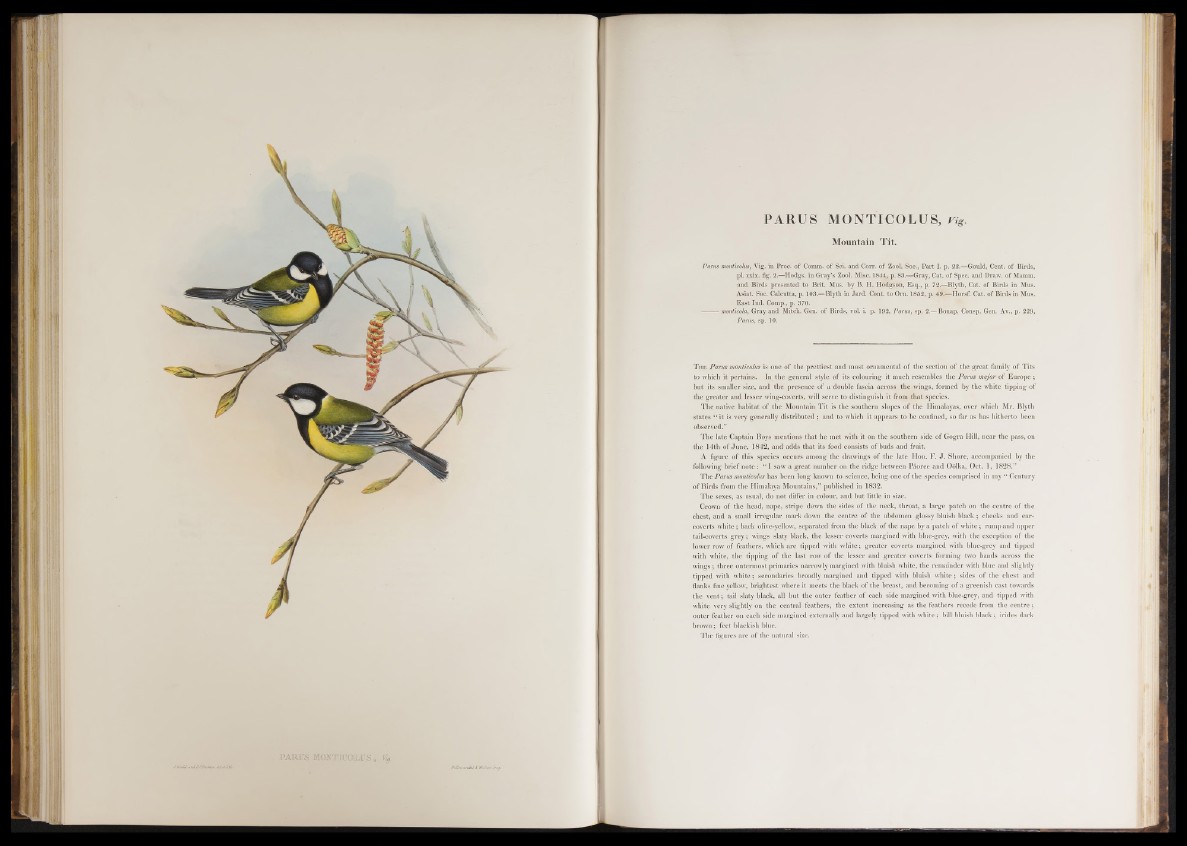
PARUS i w r i G o i
P A R U S M O N T I C O L U S , n s .
Mountain Tit.
Parus monticolus, Vig. in Proc. of Comm, of Sei. and Corr. of Zool. Soc., Part I. p. 22.—Gould, Cent, of Birds,
pi. xxix. fig. 2.—Hodgs. in Gray’s Zool. Misc. 1844, p. 83.—Gray, Cat. of Spec, and Draw, of Mamm.
and Birds presented to Brit. Mus. by B. H. Hodgson, Esq., p. 72.—Blyth, Cat. of Birds in Mus.
Asiat. Soc. Calcutta, p. 103.—Blyth in Jard. Cont. to Om. 1852, p. 49.—Horsf. Cat. of Birds in Mus.
East Ind. Comp., p. 370.
montícola, Gray and Mitch. Gen. of Birds, vol. i. p. 192, Parus, sp. 2.—Bonap. Consp. Gen. Av., p. 229,
Parus, sp. 10.
T he Parus monticolus is one of the prettiest and most ornamental of the section of the great family of Tits
to which it pertains. In the general style of its colouring it much resembles the Parus major of Europe ;
but its smaller size, and the preseuce of a double fascia across the wings, formed by the white tipping of
the greater and lesser wing-coverts, will serve to distinguish it from that species.
The native habitat of the Mountain T it is the southern slopes o f the Himalayas, over which Mr. Blyth
states “ it is very generally distributed ; and to which it appears to be confined, so far as has hitherto been
observed.”
The late Captain Boys mentions that he met with it on the southern side of G ogra Hill, near the pass, on
the 14th o f June, 1842, and adds that its food consists of buds and fruit.
A figure o f this species occurs among the drawings of the late Hon. F. J . Shore, accompanied by the
following brief n ote: “ I saw a great number on the ridge between Paoree and Oolka, Oct. 1, 1828.”
The Parus monticolus has been long known to science, being one of the species comprised in my “ Century
of Birds from the Himalaya Mountains,” published in 1832.
The sexes, as usual, do not differ in colour, and but little in size.
Crown of the head, nape, stripe down the sides of the neck, throat, a large patch on the centre of the
chest, and a small irregular mark down -the centre of the abdomen glossy bluish black; cheeks and ear-
coverts white; back olive-yellow, separated from the black o f the nape by a patch of w hite; rump and tipper
tail-coverts g rey ; wings slaty black, the lesser coverts margined with blue-grey, with the exception of the
lower row of feathers, which are tipped with wh ite; greater coverts margined with blue-grey and tipped
with white, the tipping of the last row of the lesser and greater coverts forming two bands across the
wings; three outermost primaries narrowly margined with bluish white, the remainder with blue and slightly
tipped with white; secondaries broadly margined and tipped with bluish w h ite ; sides of the chest and
flanks fine yellow, brightest where it meets the black of the breast, and becoming of a greenish cast towards
the vent; tail slaty black, all but the outer feather of each side margined with blue-grey, and tipped with
white very slightly on the central feathers, the extent increasing as the feathers recede from the c e n tre ;
outer feather on each side margined externally and largely tipped with white; bill bluish black; irides dark
brown ; feet blackish blue.
The figures are of the natural size.